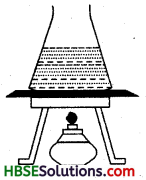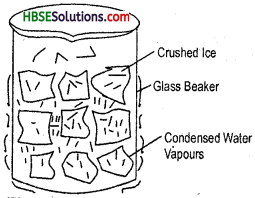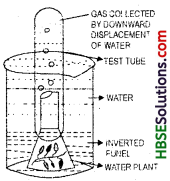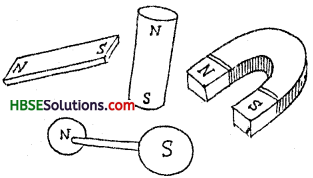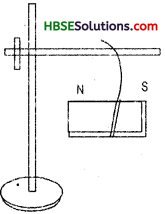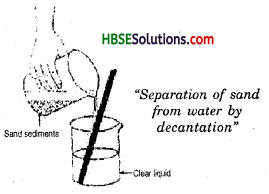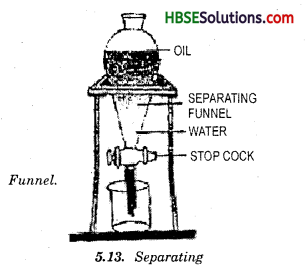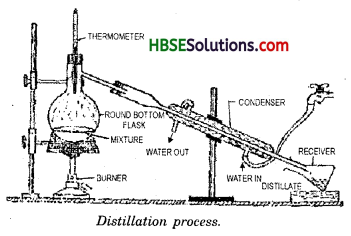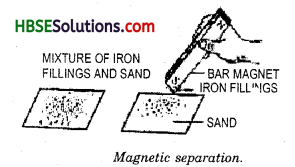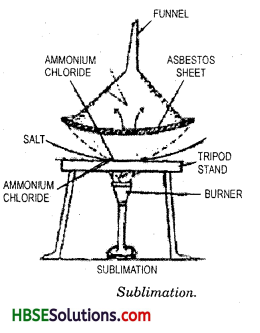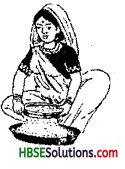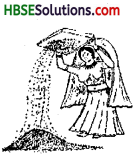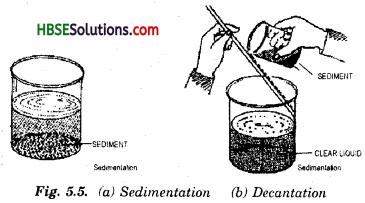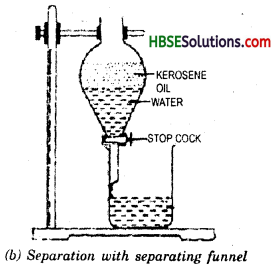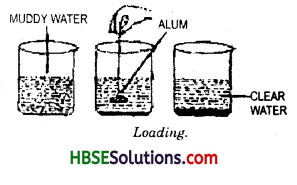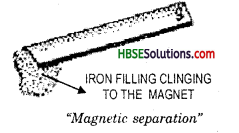HBSE 6th Class Science Solutions Chapter 1 Food: Where does it Come From
Haryana State Board HBSE 6th Class Science Solutions Chapter 1 Food: Where does it Come From Textbook Exercise Questions and Answers.
Haryana Board 6th Class Science Solutions Chapter 1 Food: Where does it Come From
HBSE 6th Class Science Food: Where does it Come From Textbook Questions and Answers
Exercises
Question 1.
Do you find that all living beings need the same kind of food?
Answer:
No, we know that different organisms eat different kinds of food. For example: animals such as buffallow and cow eat grass, oil cake, hay, grain and leaf. Rat eats grains and leftovers. Lion and tiger eat other animals. Human being eats bread, rice, fruits and vegetables. House lizards eat small insects and crow eats meat and other food items. In this way we can say that different organisms eat different kinds of food.
Question 2.
Name five plants and their parts that we eat.
Answer:
| Names of the plants | Parts that we eat |
| 1. Mustard plant | Seeds, (spices) oil and leaf. |
| 2. Brinjal | Fruits |
| 3. Carrot | Roots |
| 4. Lotus | Stem and Leaf. |
| 5. Radish | Leafs and roots. |
Question 3.
Match the items given in column ‘A’ with that in column ‘B’.
| Column A | Column B |
| 1. Milk, curd, paneer, ghee | eat other animals. |
| 2 .Spinach, cauliflower, carrot | eat plants and plants products. |
| 3. Lions & tigers | are vegetables |
| 4. Herbivorous | are all animals products. |
Answer:
- Milk, curd, paneer, ghee : are all animal products.
- Spinach, cauliflower carrot : are vegetables.
- Lions and tigers : eat other animals.
- Herbovorous : eat plants and plant products.
![]()
Question 4.
Fill up the blanks with the words given:
Herbivore, plant, milk, sugarcane, carnivore
(a) Tiger is a ________ because it eats only meat.
(b) Deer eats only plant products and so, is called ________.
(c) Parrot eats only ________ products.
(d) The ________ that we drink usually comes from cows, buffaloes and goats is an animal products.
(e) We get sugar from ________.
Answer:
(a) Carnivore
(b) herbivore
(c) plant
(d) milk
(e) sugarcane.
Things To Think About
Question 1.
Answer the following questions:
(a) Does every one around us get enough food to eat? Why?
(b) Write three ways how to avoid wastage of food?
Answer:
(a) Everyone around us does not get enough food to eat, because in our country many people are very poor. Due to lack of money, they do not get sufficient food to eat. High population growth is another factor and our country does not produce enough food for large number of people.
(b) Wastage of food can be prevented by the following methods :
- Food should be kept in close containers to protect it from germs, flies and insects.
- Fruits and vegetables should be washed properly before preparing food or before eating.
- Heating prevents food from spoiling. Many food items can be preserved simply by drying them in the sun.
- Food should be kept in ice box or refrigerators to prevent them from bacterial attack.
- Fruits and vegetables are made into jams and jelleys and pickels.
HBSE 6th Class Science Food: Where does it Come From Important Questions and Answers
Very Short Answer Type Questions
Question 1.
If a person does not get food, how does he feel?
Answer:
If a person does not get food, he feels weak and tired.
Question 2.
Why do all living beings need food?
Answer:
All living beings need food for getting energy for doing physical work.
Question 3.
If we do not eat food for one day, what will happen?
Answer:
Our ability for doing physical work will go down.
Question 4.
Do all living beings eat same type of food?
Answer:
No, all living beings eat different types of foods.
![]()
Question 5.
Which types of foods are eaten by buffalo and cow?
Answer:
They eat grass, oil cake, hay, grain and leaf.
Question 6.
Name three animals which eat only plants.
Answer:
- Cow
- Deer
- Goat.
Question 7.
Name three animals which eat both plants and animals.
Answer:
- Man
- Dog
- Crow.
Question 8.
Name three animals which eat only other animals.
Answer:
- Tiger
- King-fisher
- Vulture.
Question 9.
What is the food of a house lizard?
Answer:
A house lizard eats houseflies, mosquitoes and other insects.
Question 10.
What is the food of a cat?
Answer:
A cat eats small animals, birds, milk, fish and rat etc.
Question 11.
What are those animals called which eat plants and their products only?
Answer:
They are called herbivorous.
Question 12.
Which food items provide us energy?
Answer:
Carbohydrate and fats.
Question 13.
Name two body-building foods.
Answer:
- Milk
- Pulses.
![]()
Question 14.
What do carnivorous animals eat?
Answer:
Carnivorous animals eat other animals.
Question 15.
Name three food products we obtain from animals.
Answer:
- Milk
- egg
- meat.
Question 16.
Name three animals that provide us food.
Answer:
- Cow
- buffalo
- goat.
Question 17.
Where do we get honey?
Answer:
We get honey from honey-bees, which is collected from juice of flowers.
Question 18.
Which animals provide us milk and eggs?
Answer:
- Cow and buffalo
- hen.
Question 19.
Write down the names of some edible parts of the plants.
Answer:
Stem, roots and leaves.
Question 20.
Why do we take cooked food?
Answer:
Cooked food can easily be consumed and absorbed by our body.
Question 21.
Name two plants which provide us grains.
Answer:
- Rice
- wheat
Question 22.
Name two oil-yielding plants.
Answer:
- Mustard
- sunflower.
Question 23.
Name three fruit plants.
Answer:
- Mango tree
- papaya
- grapes.
Question 24.
Which type of food eaten by Tamilnadu people?
Answer:
Idli, dosa, sambar and coconut oil.
Question 25.
Which type of food eaten by U.P. people?
Answer:
Chapati, pulses, rice, parantha and vegetables and fruits.
Short Answer Type Questions
Question 1.
What are the different food products obtained from animals?
Answer:
Different food products obtained from animals are milk, egg, honey eat butter, honey, ghee, etc.
Question 2.
Name the animals which provide us milk, egg, meat, honey and fats.
Answer:
We get milk from cow, buffalo, goat and sheep. Eggs are provided to us from hens. Honey is obtained from honey-bees. Meat provided to us from cock, hen, deer, rabbit and buffalo etc. They also provide us fats such as pigs.
Question 3.
From which plants we obtained grains, pulses, oils and fruits? Name two each plants.
Answer:
- Grains : We obtain from rice, wheat and maize, etc.
- Pulses : We get from urad, moong, masoor and gram. etc.
- Oils: Oil yielding plants are mustard, sunflower etc.
- Fruits: Mango, orange, lichi and guava etc.
![]()
Question 4.
Name the plants from which we obtained vegetables?
Answer:
We obtain vegetables from carrot, radish, cauliflower, brinjal, cabbage and mustard plants. We obtained vegetables from their roots, stems leaves and fruits.
Question 5.
How is ghee prepared from cow milk?
Answer:
Cow milk is heated and curd is mixed in it. It is then centrifuged to obtain cream. Cream is converted to butter and after heating and filtering we obtain ghee.
Question 6.
Name six plant products which are useful to man.
Answer:
The products of plants which are useful to man are food : such as grains, pulses, oils, fruits and vegetables. We also get different type of spices from plants. We get wood, wax, lakh, silk and fibres from plants. There are so many products which are useful to mankind.
Question 7.
Name some animal products which are useful to man.
Answer:
We obtain many products from , animals. We obtain milk, eggs and meat from different animals. Many animals provide skin and ^ bones which we use in making shoes and fertilizers. Animal wastes are used as manures for improving ‘ soil fertility. They also provide us wool.
Question 8.
Why does our body need nutritious food?
Answer:
The nutritious food protects our body from many diseases and helps in building our body parts. It also helps in digestion and keep our body healthy.
Question 9.
What are the essential nutrients of our body?
Answer:
The essential nutrients of our body are:
- Carbohydrates
- Proteins
- fats
- vitamins
- minerals.
Question 10.
Why do we need carbohydrate?
Answer:
Carbohydrates such as wheat, rice, sugar and potato give us energy. We need energy for doing physical work. This energy is obtained . from carbohydrates. So it is necessary to take carbohydrates in our diet.
Question 11.
Which important mineral does milk give us? Why is it useful?
Answer:
Milk provides us an important mineral; proteins. It is necessary for the building of our ‘ body. Children’s growth and development depends upon proteins. Proteins also help in digestion. Protein also helps in the repairing of our body parts.
Long Answer Type Questions
Question 1.
Write five steps to avoid wastage of food.
Answer:
Steps to avoid wastage of food :
- All concerned must ensure that at every stage of food production, it does not get wasted, spoiled or eaten away by birds, rats and insects.
- During storage it must be protected from spoilage or from being eaten away by rodents and insects.
- While taking our meals ensure that we take only that much quantity of food which we can eat. Nothing should be left in the plate.
- We should eat only that much food which is good for us. Excess intake of food causes obesity.
- We should eat food which is easily available in the region and is seasonal.
Question 2.
What food materials come from animals?
Answer:
Food obtained from animals includes meat, fish, milk, eggs and honey.
- Meat: We get meat from animals such as goat (mutton) and chicken.
- Fish: Many kinds of fish are eaten. Fishes may be fresh water or sea water fish. The quality of food of both types of fish is good.
- Milk : We get milk from animals such as cow, goat and buffalo. Milk is used to make products such as cottage cheese (paneer), cheese, butter, cufds and ghee.
- Eggs : We get eggs from birds such as hen, goose and duck.
- Honey : We get honey from the hive of. honey bees. Honey bees prepare honey using nectar from flowers.
![]()
Food: Where does it Come From Class 6 HBSE Notes
1. Food : All living things need energy to do work; they get this energy from the food they eat.
2. Food produces energy which is required to perform various functions to sustain life. It helps us in repairing or replacing damaged cells and tissues.
3. It makes necessary materials for growth and development and reproduction. It also protects our body from disease and infections.
4. Nutrients: All the elements of food such as carbohydrate, fats, proteins, minerals and water and vitamins are essential for maintaining the life process in human
beings, so they are also called nutrients. The amount of various nutrients are different in different foods.
5. Foods are classified on the basis of their action:
- Energy-giving foods (Carbohydrates and fats): Wheat, rice, sugar, potato, oil, ghee, butter, etc.
- Body-building food : (Proteins) : It provides to the body which helps in growth, development, repair and maintenance; milk, pulses, eggs, meat.
- Protective food: This kind of food protects us from some diseases. We get these from fruits, green vegetables and other vegetables.
6. (a) Carbohydrate-rich food : Wheat, rice, potato, sugar, etc.
(b) Protein-rich food: Egg, milk, meat, fish, pulses etc.
(c) Fat-rich food : Oil, ghee, butter, groundnut etc.
(d) Vitamin-containing food: Fruits, green leafy vegetables.
(e) Mineral-containing food: Meat, fish, egg, pulses, etc.
7. On the basis of food habits, animals are divided into three major divisions :
(a) Herbivorous animals : Animals which eat plants or plant products only are called herbivorous animals. Example : Buffalo, cow etc. .
(b) Carnivorous animals : Animals which eat animals that eat plants. Example: Lizard, tiger, frog, vulture etc.
(c) Omnivorous animals : Animals which eat both animals and plants are called omnivorous. Example : Man, crow, dog, cat, etc.
8. There is a variety in the kind of food consumed even within a state.
9. We should grow more food.
10. All of us should use easily and cheaply available food in the region.
11. The food that we produce should not get spoiled or eaten away by animals.
12. Meat, egg and milk are obtained from animals. There are many such animals which provide us food.
13. Plants prepare their own food by the process of photosynthesis and all animals depend for their food directly or indirectly upon plants.
14. Water constitutes 70% of our body weight and is an important constituent of all body cells.
15. Roughage: Fibrous indigestable materials present in a food is termed as roughage.
HBSE 6th Class Science Solutions Chapter 1 Food: Where does it Come From Read More »

